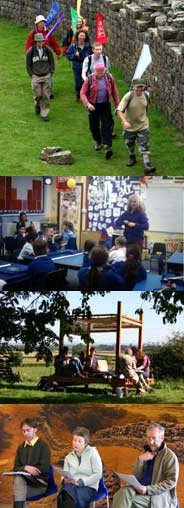
| Home page | Projects | UK Writers | Portfolio of Writing | ||||
| Workshops | International Writers | ||||||
Writing on the WallWriting on the Wall is an international Creative Writing project for Hadrian's Wall, which links with the local communities and people along the original line of the wall and its coastal defences from Wallsend and South Shields in the North East, to Bowness-on-Solway and Ravenglass in Cumbria. The project began in 2001 and was funded by One NorthEast, through the Single Regeneration Budget and with match funding from local authorities and other partners. Writing on the Wall has been created by Steve Chettle and is inspired
by the 2000 years old Vindolanda Tablets - a diverse range of writings
which include a line from Virgil's The Aeneid, a birthday
invitation, Writers from Cumbria, Northumberland, Tyne & Wear and Scotland were commissioned to work with local groups and also to produce new creative writing which links to the geographical area of Hadrian's Wall but which can be about contemporary or historical subjects. These writings are contained in each writer's page and also the portfolio of writing. Subjects include love potions, Roman herbs, the poetry of buried objects, Industrial Archaeologists, radio reception through the Tyne Tunnel, contemporary life in Byker, renga, and a complete play.
|
 |
The project also involved writers from the countries that originally garrisoned the wall - Algeria, Belgium, Bulgaria, South West and Eastern France, North Germany and the Rhineland, Greece, Holland, Hungary, Iran, Iraq, Italy, Morocco, Romania, North and North West Spain, Switzerland, European Turkey, Syria, Tunisia, Wales. The first international writers have been Hafsa Bekri-Lamrani, from Morocco; Denisa Comanescu from Romania; Hashem Shafiq from Iraq; Esther Jansma from Holland and Samuel Shimon from Iraq. A series of educational and community based workshops have taken place along the route of the wall involving people of all ages and abilities. These workshops have introduced new audiences to quality writing and have encouraged and supported new writing from the participants. New works have been created which examine historical and contemporary aspects of the Hadrian's Wall World Heritage Site. This has begun the process of making a new portfolio of creative writing about a World Heritage Site which is both ancient and modern - A.D. 122 to the 21st Century. |
|
 |
The White Door T/F: 01289 385687 Director - Steve Chettle |
![]()
All material © ARTS UK 2024 unless stated otherwise. All rights reserved. Educational and non-commercial copying, downloading and electronic storage are encouraged. All other uses must be by prior agreement with ARTS UK.
Website Designed by ARTS UK